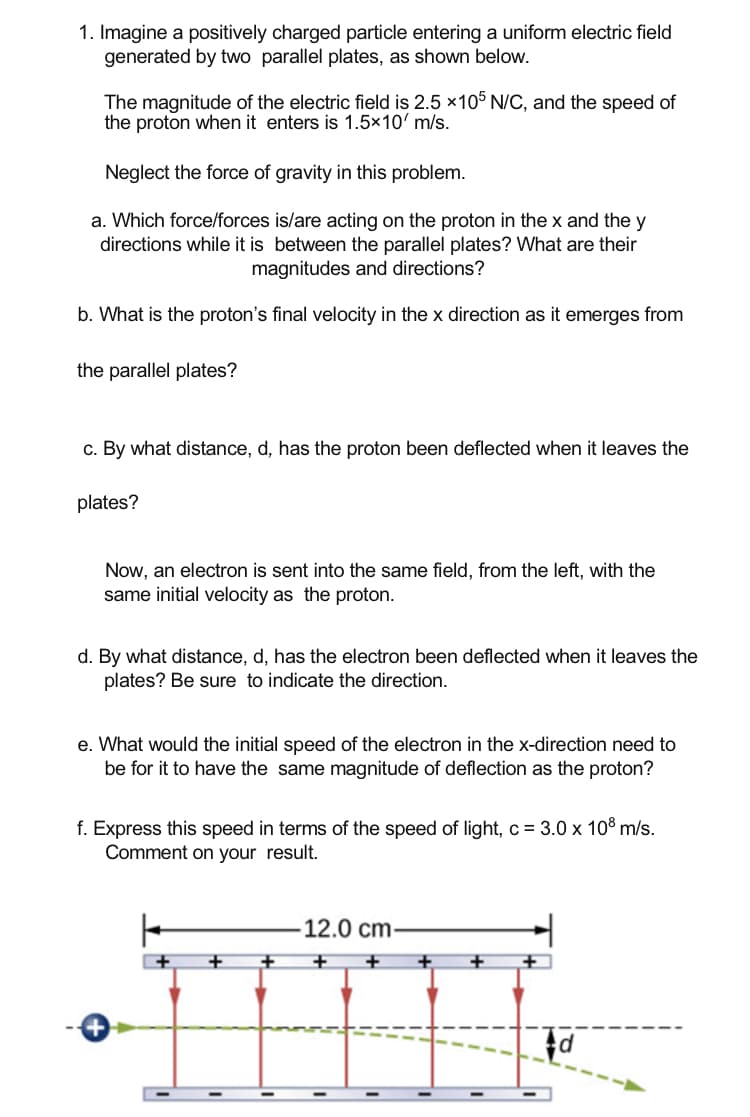Principles of Physics: A Calculus-Based Text
5th Edition
ISBN:9781133104261
Author:Raymond A. Serway, John W. Jewett
Publisher:Raymond A. Serway, John W. Jewett
Chapter20: Electric Potential And Capacitance
Section: Chapter Questions
Problem 54P: A parallel-plate capacitor has a charge Q and plates of area A. What force acts on one plate to...
Related questions
Question
Please solve d,e,f (three sub-parts)

Transcribed Image Text:1. Imagine a positively charged particle entering a uniform electric field
generated by two parallel plates, as shown below.
The magnitude of the electric field is 2.5 x105 N/C, and the speed of
the proton when it enters is 1.5×10' m/s.
Neglect the force of gravity in this problem.
a. Which force/forces is/are acting on the proton in the x and the y
directions while it is between the parallel plates? What are their
magnitudes and directions?
b. What is the proton's final velocity in the x direction as it emerges from
the parallel plates?
c. By what distance, d, has the proton been deflected when it leaves the
plates?
Now, an electron is sent into the same field, from the left, with the
same initial velocity as the proton.
d. By what distance, d, has the electron been deflected when it leaves the
plates? Be sure to indicate the direction.
e. What would the initial speed of the electron in the x-direction need to
be for it to have the same magnitude of deflection as the proton?
f. Express this speed in terms of the speed of light, c = 3.0 x 10% m/s.
Comment on your result.
-12.0 cm-
Expert Solution
This question has been solved!
Explore an expertly crafted, step-by-step solution for a thorough understanding of key concepts.
Step by step
Solved in 2 steps with 2 images

Knowledge Booster
Learn more about
Need a deep-dive on the concept behind this application? Look no further. Learn more about this topic, physics and related others by exploring similar questions and additional content below.Recommended textbooks for you

Principles of Physics: A Calculus-Based Text
Physics
ISBN:
9781133104261
Author:
Raymond A. Serway, John W. Jewett
Publisher:
Cengage Learning

College Physics
Physics
ISBN:
9781938168000
Author:
Paul Peter Urone, Roger Hinrichs
Publisher:
OpenStax College

College Physics
Physics
ISBN:
9781285737027
Author:
Raymond A. Serway, Chris Vuille
Publisher:
Cengage Learning

Principles of Physics: A Calculus-Based Text
Physics
ISBN:
9781133104261
Author:
Raymond A. Serway, John W. Jewett
Publisher:
Cengage Learning

College Physics
Physics
ISBN:
9781938168000
Author:
Paul Peter Urone, Roger Hinrichs
Publisher:
OpenStax College

College Physics
Physics
ISBN:
9781285737027
Author:
Raymond A. Serway, Chris Vuille
Publisher:
Cengage Learning


Physics for Scientists and Engineers, Technology …
Physics
ISBN:
9781305116399
Author:
Raymond A. Serway, John W. Jewett
Publisher:
Cengage Learning

Physics for Scientists and Engineers with Modern …
Physics
ISBN:
9781337553292
Author:
Raymond A. Serway, John W. Jewett
Publisher:
Cengage Learning